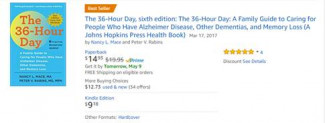
Johns Hopkins UniversityEst. 1876
America’s First Research University
From Here to There: Amazon Author Pages

I didn’t set out to focus on Amazon in this column, but it seems that is where most of the questions (and misinformation) come from. I’ve thus far discussed buy buttons and sales rankings, and now I want to turn to author pages.
One of the things that Amazon gets right is linking and connecting all of the pieces of book data to create multiple paths to purchase. The detail pages tout the specific book, but from there web spreads out to include the author’s other titles. Authors have the ability to create author pages, linking all of the books they have published together, supplemented with additional information.
Note below how Nancy L. Mace’s name is hyperlinked, by Peter V. Rabins’s is not.

That is because Ms. Mace has set up an author page:


Author pages are available to authors and require that authors place a request to claim the page. Publishers are then contacted to confirm the person claiming the book is who they say they are. Authors can further utilize Author Central, which provides sales data, as well as additional ways to add content and marketing opportunities.
To illustrate the behind-the-scenes action on Author Central I am going to use my own account. Sales are slim, data is scant, and I am relatively unpopular, but you’ll get the idea.
As you can see, Amazon immediately starts pitching its services as publisher.

On the Author Page tab, authors are encouraged to share additional details, links, images, and videos that are displayed on the customer-facing Author Page.

On the Books tab, all books connected to the author are displayed. If books are missing or not linked properly, you can click the “add more books” button and provide Amazon with the necessary details. I noticed my name was spelled a few different ways, causing some of my books not to link. I notified Amazon and corrections were made within 30 minutes.

Perhaps the most worthwhile, yet concerning, feature is the Sales Info tab.

Authors can see how their books are selling nationally with the Nielson BookScan link. Prior to Amazon making this accessible to authors, this information was primarily available to publishers and distributors, and at a sizable cost. The page notes the number of units sold, by title or total, over period of time. Sales trends displayed as well. Note that Amazon only provides BookScan data, not their own sales data.

Amazon also shows where books fit in the bestseller rankings and any movement on the rank.

Lastly, the author’s rank on Amazon is available, both in real time and historically.

Having worked in distribution for almost 15 years, I can see how incredibly useful this information is to authors. Many of the calls and emails I used to receive had to do with sales numbers and attempting to track/analyze this sort of data. Additionally, giving authors the ability to enhance their book data and information is remarkably helpful and often publishers don’t have the time and resources to add robust author content.
That said, Amazon isn’t known for altruistic support. Again and again, we have seen Amazon create wedges between authors and publishers/distributors. Even now, as more books are pointing to used copies, causing authors to lose royalties, many authors remain cheerleaders for Amazon. Authors should definitely use the tools available to them to work with their publishers and understand that these are tools, not weapons.
